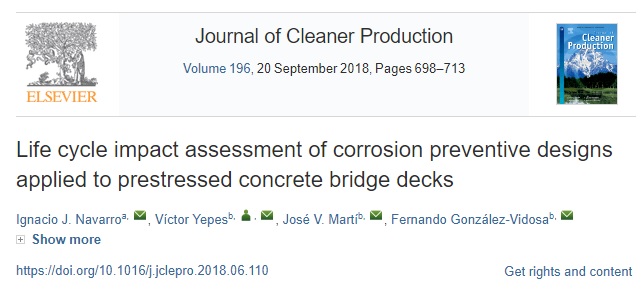 Acaban de publicarnos un artículo en la revista Environmental Impact Assessment Review (primer decil del JCR), de la editorial ELSEVIER, en el que se realiza una valoración de las medidas preventivas consideradas en el proyecto a lo largo del ciclo de vida de un puente de hormigón sometido a un ambiente costero, donde los clorhídricos suponen una agresión que supone un mantenimiento de la infraestructura. En el artículo se analizan 15 diseños diferentes y se comprueba que no siempre ejecutar un mantenimiento mínimo supone menores impactos ambientales. Además, los tratamientos superficiales y la adición de humo de sílice supone una reducción del 70% en los impactos.
Acaban de publicarnos un artículo en la revista Environmental Impact Assessment Review (primer decil del JCR), de la editorial ELSEVIER, en el que se realiza una valoración de las medidas preventivas consideradas en el proyecto a lo largo del ciclo de vida de un puente de hormigón sometido a un ambiente costero, donde los clorhídricos suponen una agresión que supone un mantenimiento de la infraestructura. En el artículo se analizan 15 diseños diferentes y se comprueba que no siempre ejecutar un mantenimiento mínimo supone menores impactos ambientales. Además, los tratamientos superficiales y la adición de humo de sílice supone una reducción del 70% en los impactos.
Asimismo, podéis solicitar al autor una copia en la plataforma Researchgate: https://www.researchgate.net/publication/325690791_Life_cycle_impact_assessment_of_corrosion_preventive_designs_applied_to_prestressed_concrete_bridge_decks
Referencia:
NAVARRO, I.J.; YEPES, V.; MARTÍ, J.V.; GONZÁLEZ-VIDOSA, F. (2018). Life cycle impact assessment of corrosion preventive designs applied to prestressed concrete bridge decks. Journal of Cleaner Production, 196:698-713. https://doi.org/10.1016/j.jclepro.2018.06.110
Abstract:
Chloride corrosion of reinforcing steel in concrete structures is a major issue in the construction sector due to economic and environmental reasons. Assuming different prevention strategies in aggressive marine environments results in extending the service life of the exposed structures, reducing the maintenance actions required throughout their operation stage. The aim of the present study is to analyze the environmental implications of several prevention strategies through a life cycle assessment using a prestressed bridge deck as a case study.
The environmental impacts of 15 prevention alternatives have been evaluated when applied to a real case of study, namely a bridge deck exposed to a chloride laden surrounding. The Eco-indicator 99 methodology has been adopted for the evaluation of the impacts. As some of the alternatives involve the use of by-products such as fly ash and silica fume, economic allocation has been assumed to evaluate their environmental impacts.
Results from the life cycle analysis show that the environmental impacts of the chloride exposed structure can be reduced significantly by considering specific preventive designs, such as adding silica fume to concrete, reducing its water to cement ratio or applying hydrophobic or sealant treatments to its surface. In such scenarios, the damage caused to the environment mainly due to maintenance operations and material consumption can be reduced up to a 30–40% of the life cycle impacts associated to a conventional design. The study shows how the application of life cycle assessment methodologies can be of interest to reduce the environmental impacts derived from the maintenance operations required by bridge decks subjected to aggressive chloride laden environments.
Keywords:
Life cycle assessment; Chloride corrosion; Preventive measures; Eco-indicator 99; Bridge deck; Sustainable design; Concrete
Highlights:
- Life cycle assessment of different design strategies for bridge decks in marine environments.
- 15 different design alternatives were studied and compared with the conventional design.
- Less maintenance does not always result in lower environmental impacts.
- Steel and maintenance are main contributors to environmental burdens.
- Surface treatments and the addition of silica fume reduce impacts up to 70%.
